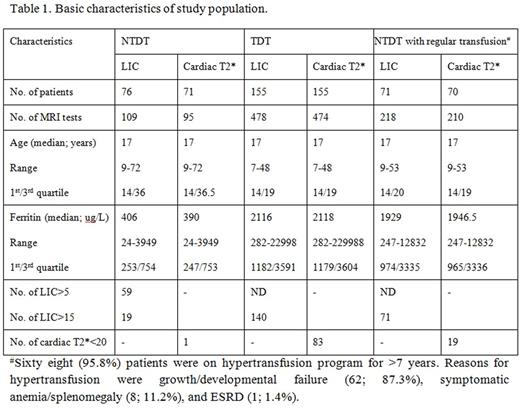Abstract

Introduction: Although routine tissue iron monitoring using magnetic resonance imaging (MRI) has become a standard clinical management of both transfusion dependent and non-transfusion dependent thalassemias (TDT & NTDT) in several developed countries since this module can provide a better organ-directed iron measurement and related to clinical outcome including morbidity and mortality secondary to iron overload (IOL). However, accessibility of this monitoring remains limited in several developing countries including Thailand, where thalassemia and hemoglobinopathies are highly prevalent. Earlier in 2016, we have demonstrated that although not so perfectly crafted, a cross-sectional measurement of serum ferritin (SF) can be used for determination of IOL as a predictive marker; in NTDT, MRI for liver iron concentration (LIC) should be performed in those with SF >300 ug/L and for TDT, the SF cut off of >2,500 and >3,500 ug/L are useful to predict patients with severe LIC (>15 mgFe/g dw) and cardiac siderosis (T2*< 20 ms) (Ekwattanakit S. et.al., EHA 2016). In this study, we performed a further analysis to evaluate whether a serial measurement of SF and its trend can provide a better prediction.
Objectives: To evaluate the clinical utility of serial SF trend compared with a cross-sectional SF cut-off for early detection of IOL in a real-life practice in thalassemic patients in order to select the most vulnerable patients for further MRI evaluation in a resource limited setting.
Methods: In this prospective study, total 968 standard MRI for LIC and cardiac T2*were performed at Siriraj hospital during 2009-2014 and paired clinical data including serial SF measurements were collected from 301 thalassemia patients; NTDT (N=76; 109 LIC and 95 cardiac T2* results) and TDT (N=155; 478 LIC and 474 cardiac T2*). In addition, 71 patients were NTDT with regular blood transfusion later on in their life, mainly Hb E/β thalassemia (218 LIC and 210 cardiac T2*). These patients were evaluated for IOL using SF every 4-12 weeks during their follow up. Median follow up time was 96 months. Receiver operating characteristic (ROC) analysis was performed using different SF cut-off levels (1000, 1500 and 2000ug/L) and percentage of serial SF measurements that above each these cut-off levels (50 and 75%) during different durations before MRI (1, 2, or 3 years priori) for predicting liver IOL (LIC >5 in NTDT and severe liver siderosis; LIC > 15 mgFe/g dw) and cardiac IOL (T2*<20ms).
Results: Baseline characteristics were shown in Table1. In NTDT, using ROC analysis, SF >1000 ug/L over 75% of serial measurements in 1-year period prior to MRI can predict LIC > 5 mgFe/g dw with the AUC of 0.59 with PPV 86.7% and NPV 51.1% and serial SF >1500 ug/l over 50% of measurement in a year prior predict LIC >15 mgFe/g dw (AUC of 0.72, PPV 75% and NPV 89.7%). Only 1 NTDT had cardiac IO. These newly identified criteria do not provide a more sensitive predictor of LIC results than our previous SF cut-off. In TDT population, the majority of patients were HbE/β thal (78%) and cardiac iron overload was detected mainly in patients older than 15 yrs (81/83; 97.6%). The best predictor for LIC>15 mgFe/g dw was SF >2000 ug/L over 75% of serial measurement durations in 3-year period (AUC 0.778, PPV 50.8%, NPV 95.5%). However this cut-off during 1 year priori also provided a similar prediction (AUC 0.769, PPV 51%, NPV 93.6%). This cut-off value also provided the best prediction for cardiac T2* < 20 ms in all age group (AUC 0.754, PPV 31.5%, NPV 97.4%) and a higher sensitivity and specificity when it was applied in patients >15 yrs of age (AUC 0.764, PPV 41.9%, NPV 96.3%). In NTDT with regular transfusion, all cardiac IOL (N=19) occurred after 15 years of age and again the same criteria was the good predictive cut-off for cardiac IO (AUC 0.788, PPV 19%, NPV 100%) and severe LIC >15 mgFe/g dw (AUC 0.728, PPV 52.8%, NPV 87.3%).
Conclusions: In a resource limited setting for MRI evaluation, a serial measurement of SF and its values in thalassemic patients who received regular blood transfusion above the cut-off of 2000 ug/L over 75% of measurement in one year priori could be used as a predictive marker for selecting the most vulnerable TDT for MRI evaluation since this criteria is strongly associated with severe liver (LIC > 15 mgFe/g dw) and cardiac siderosis (T2* <20 ms). Moreover this criterion provides a more sensitive predictor than a single SF cut-off we proposed before.
Siritanaratkul:Novartis: Research Funding; Jansen-Cilag: Research Funding; Roche: Research Funding; Pfizer: Research Funding. Wood:Celgene: Consultancy; AMAG: Consultancy; Ionis Pharmaceuticals: Consultancy; Ionis Pharmaceuticals: Consultancy; World Care Clinical: Consultancy; Biomed Informatics: Consultancy; Vifor: Consultancy; Apopharma: Consultancy; Biomed Informatics: Consultancy; Vifor: Consultancy; Apopharma: Consultancy; World Care Clinical: Consultancy; AMAG: Consultancy; Celgene: Consultancy. Viprakasit:Agios: Consultancy; Mersanger: Consultancy; Novartis: Consultancy, Honoraria, Research Funding, Speakers Bureau; Celgene Corporation: Consultancy, Research Funding; Faculty of Medicine, Siriraj Hospital, Mahidol University: Employment; Shire: Research Funding.
Author notes
Asterisk with author names denotes non-ASH members.

This icon denotes a clinically relevant abstract


This feature is available to Subscribers Only
Sign In or Create an Account Close Modal